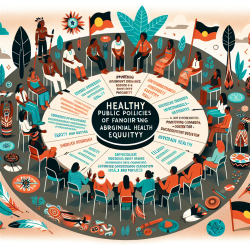Introduction
In the landscape of Canadian public health, the persistent inequities faced by Aboriginal communities highlight a critical need for reform. The research article "Creating conditions for Canadian aboriginal health equity: the promise of healthy public policy" by Richmond and Cook underscores the importance of developing healthy public policies that prioritize the rights and well-being of Aboriginal peoples. As practitioners, it is imperative to understand and implement the outcomes of this research to foster health equity and support community self-determination.
The Historical Context
The Indian Act of 1876, a cornerstone of Canadian policy, has historically marginalized Aboriginal communities, perpetuating health and social inequities. This legislation, rooted in colonialism, has shaped public perceptions and policies, contributing to systemic racism and gender discrimination. Recognizing these historical injustices is crucial for practitioners aiming to address contemporary health disparities.
Challenges and Opportunities
Despite these challenges, there is significant promise in community-led health initiatives and research as advocacy for policy reform. The First Nation Health Authority (FNHA) in British Columbia exemplifies the potential of Aboriginal self-determination in health care, demonstrating how community engagement can lead to innovative health service delivery models.
Implementing Healthy Public Policy
Practitioners can play a pivotal role in advancing healthy public policy by:
- Advocating for policies that recognize the unique cultural contexts and rights of Aboriginal peoples.
- Supporting community-based research that empowers Indigenous communities to shape health policies.
- Promoting education and training programs that increase cultural competence among health professionals.
By embracing these strategies, practitioners can contribute to a more equitable health system that respects the self-determination and rights of Aboriginal communities.
Encouraging Further Research
To further enhance their skills, practitioners are encouraged to engage with the original research article and explore additional studies on Aboriginal health equity. This continuous learning approach will equip practitioners with the knowledge needed to advocate for systemic change and support the creation of healthy public policies.
Conclusion
In conclusion, the journey towards Aboriginal health equity requires a collective effort from practitioners, policymakers, and communities. By implementing the outcomes of Richmond and Cook's research, practitioners can drive meaningful change and help build a more inclusive and equitable health system for all Canadians.
To read the original research paper, please follow this link: Creating conditions for Canadian aboriginal health equity: the promise of healthy public policy.










